Lake Michigan is an impressive lake. It’s one of the world’s largest with a surface area of 22,404 square miles. It’s a freshwater ocean! Have you ever wondered about the creatures that lurk within Lake Michigan? Although most are harmless to humans, some can be dangerous. Follow along to discover 12 creatures living in Lake Michigan and some fun facts about this massive lake.
About Lake Michigan
Before we dive into the creatures living in Lake Michigan, let’s learn more about this large body of water. Lake Michigan is 307 miles long and 91 miles wide. The average depth of this lake is 279 feet, while the maximum recorded depth is 923 feet. Lake Michigan is so big that it has a shore length of around 1,400 miles, not including the islands. There are several islands within this massive freshwater body of water, many of which you can visit. The largest island in Lake Michigan is Beaver Island. It has a surface area of 55.8 square miles.
Lake Michigan is sometimes called ‘the Third Coast of the United States’ because of its sparkling beaches. The sand surrounding the beaches is soft and off-white. Many major cities and states surround this gorgeous lake.
States along Lake Michigan are Michigan, Wisconsin, Illinois, and Indiana. There are also many state parks along Lake Michigan. Some of the more popular state parks on Lake Michigan include Harrington Beach State Park, Silver Lake State Park, Indiana Dunes State Park, and Ludington State Park.

Lake Michigan is 307 miles long and 91 miles wide with a surface area of 22,404 square miles.
©John Brueske/Shutterstock.com
13 Creatures Living in Lake Michigan
Now that we know a little more about this vibrant and incredible lake, we can dive into the creatures that call it home. There are also many animals though that don’t live in the lake but around it. For instance, around Lake Michigan, you may find animals like black bears, bobcats, wolves, coyotes, whitetail deer, and moose.
1. Lake Trout

Lake trout are usually brown or olive-gray and feature yellowish or white spots; their underparts are typically white.
©Iryna Harry/Shutterstock.com
The first animal on our list is the lake trout. They are native to North America. These freshwater fish are popular game fish in Lake Michigan. Lake trout are found throughout the United States because of introductions, although they are only native to parts of eastern and northern North America. You can also find non-native lake trout in Asia, Europe, and South America. This fish species has brown or olive-gray skin with yellowish or white spots and light yellow or white bellies. Although most lake trout have similar coloration, they vary a lot in size. The largest lake trout ever caught weighed 102 pounds. Although the largest recorded, it’s not the world record lake trout.
2. Lake Whitefish
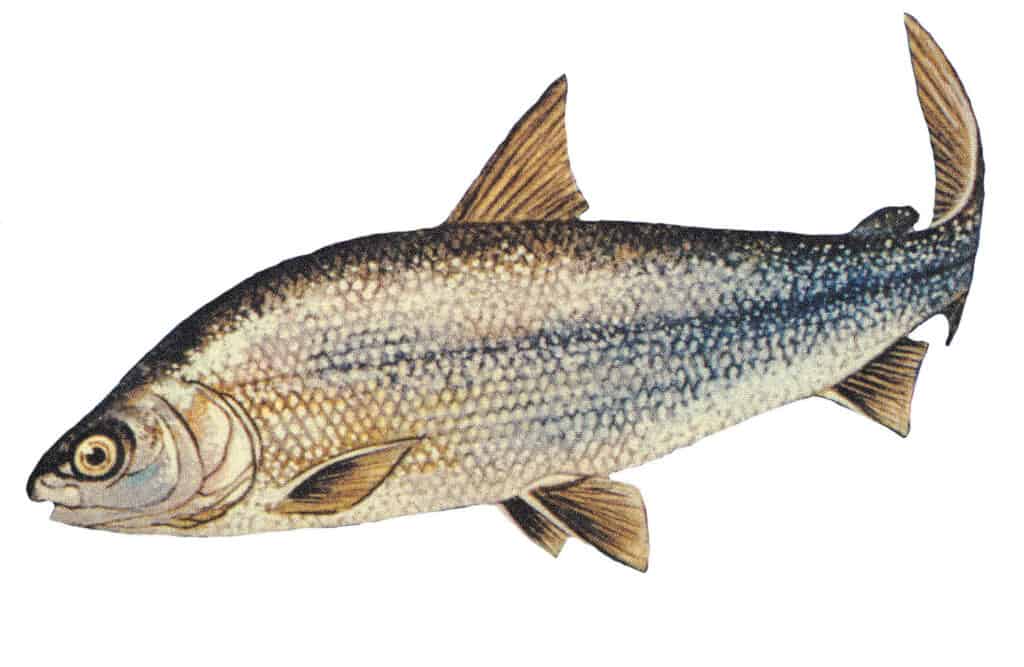
On average, lake whitefish weigh about 1 to 4 pounds, but the largest recorded lake whitefish was a little over 42 pounds.
©NOAA Great Lakes Environmental Research Laboratory / flickr – License
Another creature living in Lake Michigan is the lake whitefish. This fish species has a similar distribution to the lake trout. It’s native to northern North America, mostly in Canada. However, lake whitefish have been widely introduced to most states in the United States. Lake whitefish vary a lot in size. Some mature lake whitefish can weigh as little as 1.5 pounds or as much as 42 pounds. However, on average, lake whitefish weigh 1 to 4 pounds. The best time to fish for lake whitefish is from winter to early spring.
3. Smallmouth Bass

The largest smallmouth ever caught weighed 12 pounds and was over 2 feet long.
©Ryno Botha/Shutterstock.com
One of the most common fish in the United States is the smallmouth bass. They are abundant in Lake Michigan. Smallmouth bass are freshwater fish in the Centrarchidae family. Because of their abundance and wide distribution, this fish species is listed as the Least Concern on the IUCN Red List. These medium-sized fish are generally about 2 to 6 pounds. The largest smallmouth bass though ever caught was a monster. It weighed 12 pounds and was over 2 feet long! Smallmouth bass fishing is a popular hobby and sport that’s been around for centuries. These powerful swimming fish were first brought outside of their native range in 1825.
4. Kirtland’s Snake

The scales on a Kirtland’s snake’s top side are keeled, giving a textured feel to their skin.
©Mike Wilhelm/Shutterstock.com
Also in Lake Michigan is Kirtland’s snake, although this snake species isn’t a permanent resident. It also lives on land. The Kirtland’s snake is a small snake that can grow up to 24.5 inches long. However, the average Kirtland’s snake is 14 to 18 inches long. You can identify this snake species by its reddish to dark brown skin with four rows of alternating dark, round markings. They also have vibrant red, pink, or orange bellies bordered by two rows of black spots. In Michigan, they are only found in a few counties. These snakes mainly occupy open wetlands but have been found in urban locations like parks and neighborhoods.
5. Yellow Perch

Yellow perch are native to Lake Michigan.
©RLS Photo/Shutterstock.com
Another fish species to make it on our list of creatures living in Lake Michigan is the yellow perch. Yellow perch are native to Lake Michigan and are a popular panfish. You can mainly find these sparkling striped fish in shallow water. Yellow perch are listed as Least Concern on the IUCN Red List and Secure by the NatureServe conservation status system. These fish are native to the tributaries of the Atlantic Oceans and Hudson Bay in North America. They’ve been introduced to many other parts of the world though. Interestingly, we still don’t know a lot about yellow perch. For instance, although a few small populations of yellow perch exist in Florida, experts aren’t completely sure if they are native.
6. Coho Salmon
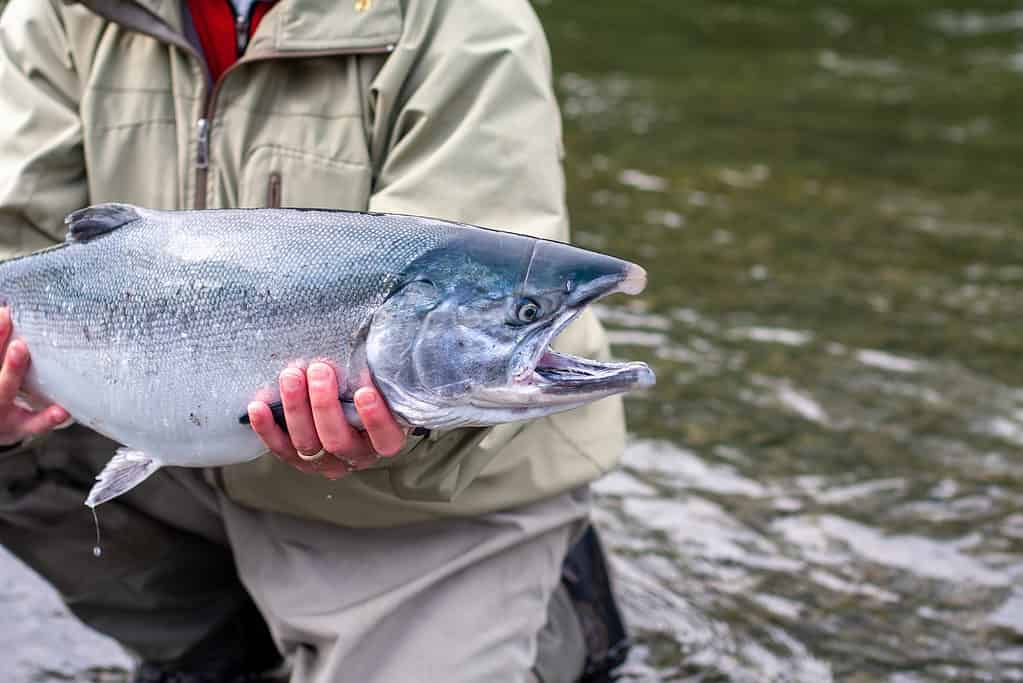
Coho salmon may weigh over 30 pounds. On average, coho salmon are about 8 to 12 pounds.
©iStock.com/christiannafzger
Coho salmon are one of the largest fish species in Lake Michigan. They are especially abundant in early spring and late summer, however, you can fish for them during any season. Coho salmon vary in appearance, although they are generally silvery fish with blue or greenish backs and a light belly. This salmon species changes a lot when spawning. During this time, they have reddish-pink sides. Males also develop a strongly hooked snout and large teeth. They can weigh over 30 pounds but are more commonly 8 to 12 pounds.
7. Sea Lamprey
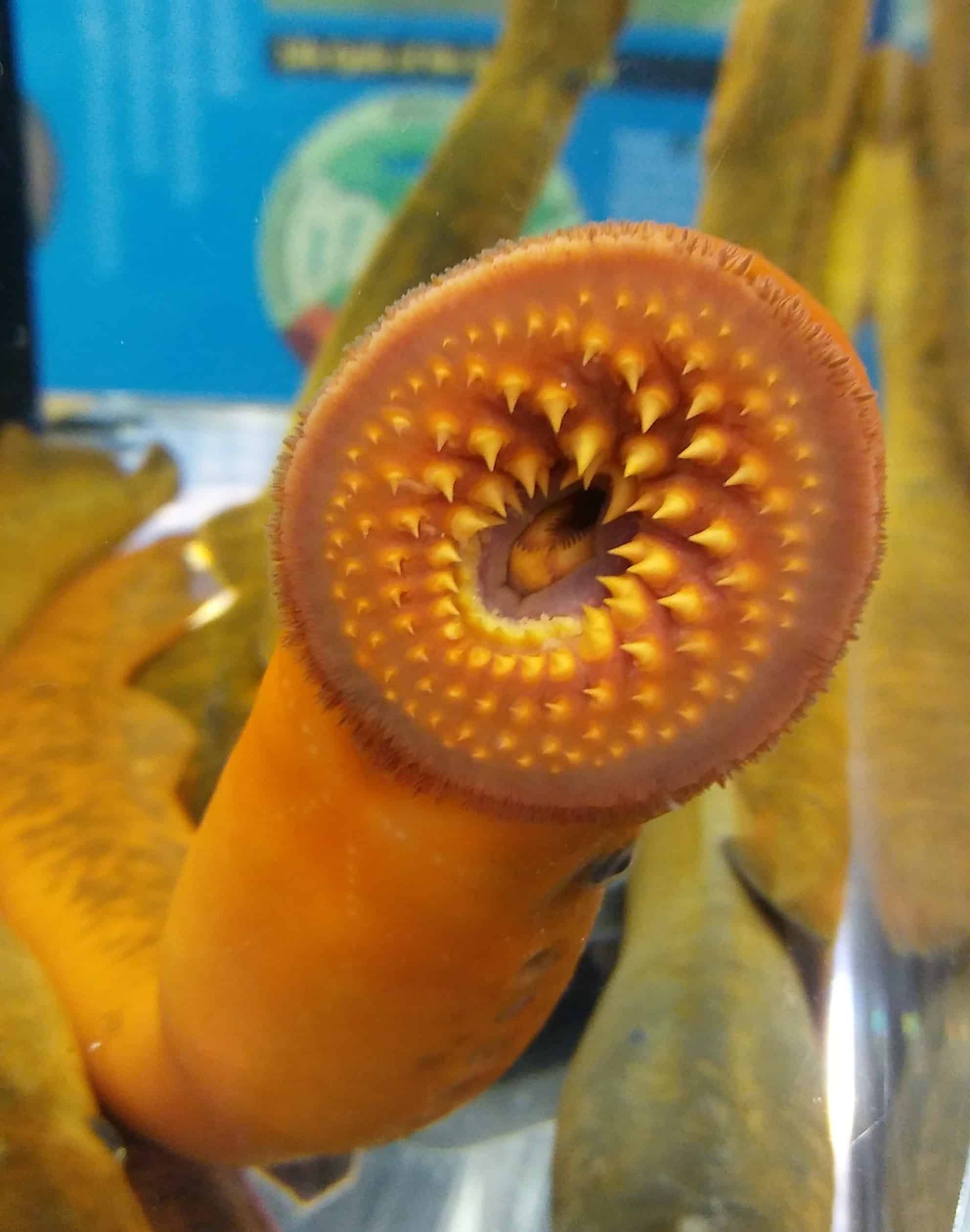
Although sea lampreys are invasive creatures in Lake Michigan, they are harmless to humans.
©Theresa Grace/Shutterstock.com
Sadly, sea lampreys have infiltrated Lake Michigan. Although harmless to humans, these vampire fish pose a large threat to many native fish species in lakes, and Lake Michigan is no exception. Sea lampreys have eel-like bodies with 2 close dorsal fins and 7 gill openings. These nightmarish-looking creatures though are easier to identify from their large mouths that contain sharp, curved teeth and rasping tongues. These jawless animals are parasitic. They latch onto their host, like lake trout and lake whitefish, and feed on their body fluids. This process can kill their host.
8. Zebra Mussel
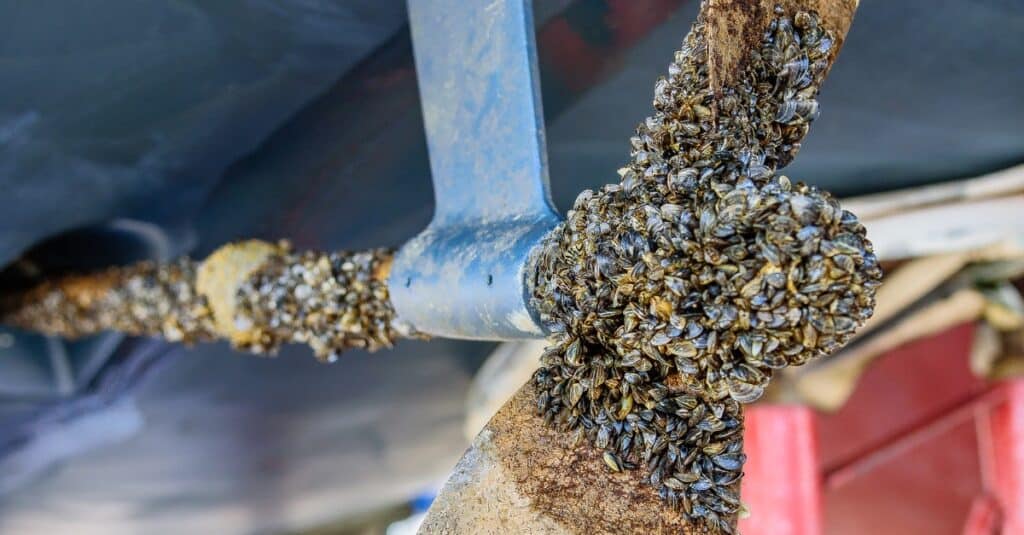
Zebra mussels have been in the Great Lakes since the 1980s.
©iStock.com/JeffCaughey
Another invasive species to make our list is the well-known and frustrating zebra mussel. Zebra mussels are dangerous as they spread quickly and can harm the ecosystem of a lake, but like sea lampreys aren’t dangerous to humans. These mussels are native to southern Russia and Ukraine but have a wide distribution because of accidental introductions. They’ve been in the Great Lakes since the 1980s. Zebra mussels are fingernail-sized mollusks with zebra-like patterns. They are dangerous to habitats as they compete with native mussels and kill them. They also filter out algae needed as food for some animals. These mussels also clog pipes made to distribute water.
9. Quagga Mussel

The quagga mussel is a highly invasive species in Lake Michigan. It’s a little larger than a zebra mussel.
©Chris Dale/Shutterstock.com
Another dangerous mussel on our list (although directly harmless to humans), is the quagga mussel. This freshwater mollusk is a member of the Dreissenidae family. Because of their wide distribution due to accidental introductions, they are listed as Least Concern on the IUCN Red List. Quagga mussels are a little larger than zebra mussels but are also only about 0.8 inches wide. Don’t let their short size fool you, quagga mussels are destructive and reproduce quickly. These filter feeders can filter one liter or more of water each day including algae, phytoplankton, and zooplankton. The first recording of a highly invasive quagga mussel in North America was in 1989 in Lake Erie near Port Colborne, Ontario. This specimen wasn’t identified until 1991.
10. Common Snapping Turtle
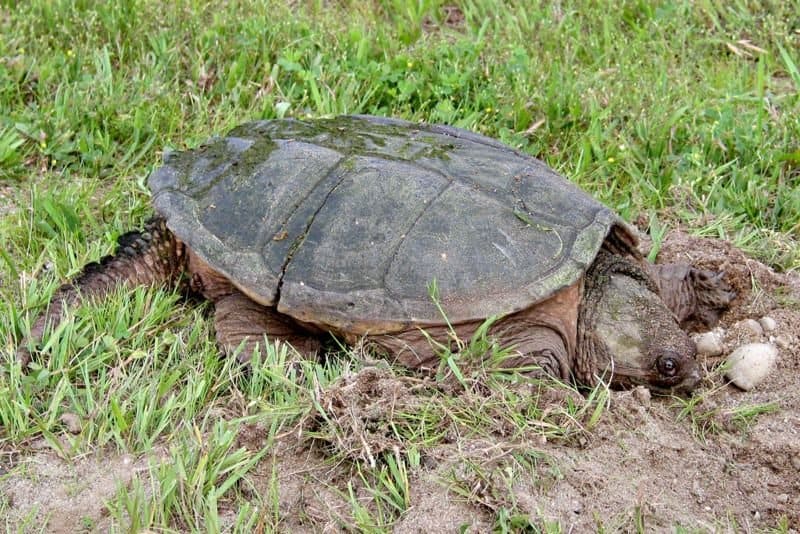
Common
snapping turtles
rarely bite or attack humans.
While common snapping turtles may attack or bite humans, these instances are rare. Common snapping turtles rarely bother humans. They only bite when they feel threatened or uncomfortable. So, as long as you don’t intentionally harass a snapping turtle, you shouldn’t feel threatened. Still, they have a fast and powerful bite with a bite force of about 210 Newtons, which may be enough to cause skin damage.
Common snapping turtles are found throughout Lake Michigan. They are more common in shallow parts of the lake and may be spotted resting on logs on the surface of the lake. Common snapping turtles are also large. They are the largest turtle species in Michigan with a top shell size of 20 inches.
11. Painted Turtle

Painted turtles pose no threat to humans.
©iStock.com/Wildpix645
Although painted turtles can bite, their mouths are so small they barely inflict damage. However, a painted turtle bite can still be painful. These feisty turtles are small but mighty. They are known to bite when irritated or scared. If you pick them up, they can also scratch your skin with their claws.
Painted turtles are found throughout North America. They are very abundant and are listed as Least Concern on the IUCN Red List. These turtles are about 5 to 10 inches long. They have a similar appearance to the red-eared slider.
12. Copperbelly Water Snake
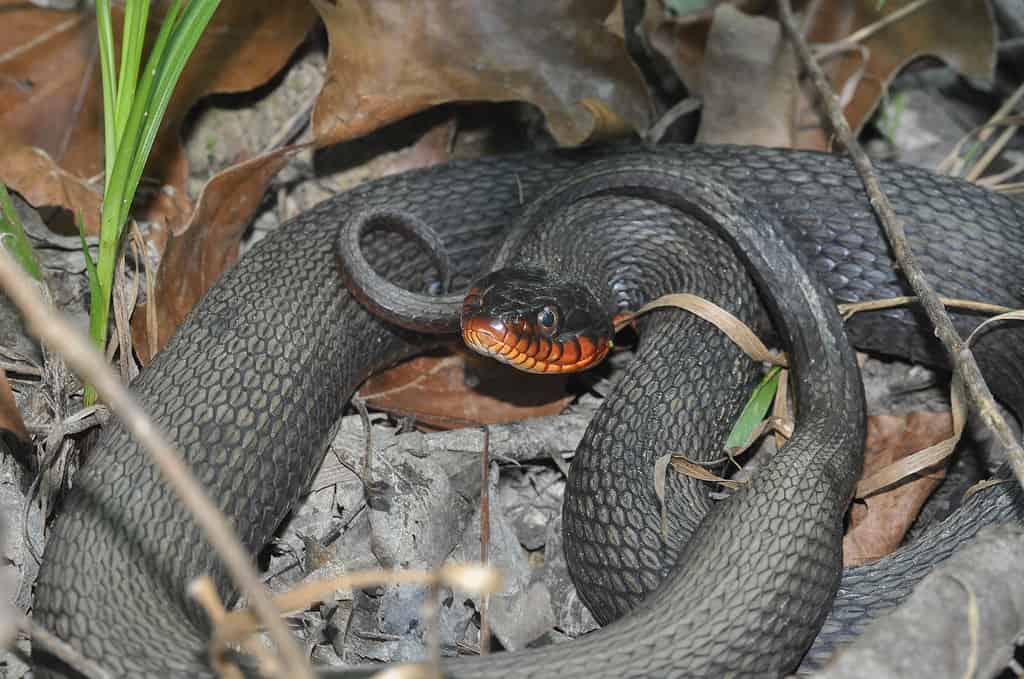
Copperbelly water snakes are very similar to their yellowbelly counterparts, except they have copper-colored bellies instead of yellow-colored ones.
©Mike Wilhelm/Shutterstock.com
Last but not least on our list of 12 creatures living in Lake Michigan is the copperbelly water snake. While water snakes are feared by many, this species is nonvenomous, however, their bites are still painful. Copperbelly water snakes have solid black or black-blue backs and orange-red bellies. They are about 3 to 5 feet long, although the largest recorded copperbelly water snake was 65.5 inches. While you can find these snakes in Lake Michigan, sightings aren’t common. Sadly, they are endangered.
The photo featured at the top of this post is © Darlene Stanley/Shutterstock.com
Thank you for reading! Have some feedback for us? Contact the AZ Animals editorial team.







